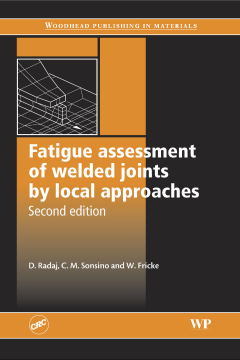
BOOK
Fatigue Assessment of Welded Joints by Local Approaches
Dieter Radaj | C M Sonsino | W Fricke
(2006)
Additional Information
Book Details
Abstract
Local approaches to fatigue assessment are used to predict the structural durability of welded joints, to optimise their design and to evaluate unforeseen joint failures. This standard work provides a systematic survey of the principles and practical applications of the various methods. It covers the hot spot structural stress approach to fatigue in general, the notch stress and notch strain approach to crack initiation and the fracture mechanics approach to crack propagation. Seam-welded and spot-welded joints in structural steels and aluminium alloys are also considered.
This completely reworked second edition takes into account the tremendous progress in understanding and applying local approaches which has been achieved in the last decade. It is a standard reference for designers, structural analysts and testing engineers who are responsible for the fatigue-resistant in-service behaviour of welded structures.
- Completely reworked second edition of a standard work providing a systematic survey of the principles and practical applications of the various methods
- Covers the hot spot structural stress approach to fatigue in general, the notch stress and notch strain approach to crack initiation and the fracture mechanics approach to crack propagation.
- Written by a distinguished team of authors
"...a standard reference for designers, structural analysts and testing engineers." --Welding and Cutting
Table of Contents
| Section Title | Page | Action | Price |
|---|---|---|---|
| Cover | Cover | ||
| Fatigue assessment of welded joints by local approaches | iii | ||
| Copyright | iv | ||
| Contents | v | ||
| Foreword | xv | ||
| Preface | xvii | ||
| Author contact details | xix | ||
| 1 Introduction | 1 | ||
| 1.1 Fatigue strength assessment of welded joints | 1 | ||
| 1.2 Basic aspects of assessment procedures | 3 | ||
| 2 Nominal stress approach for welded joints | 13 | ||
| 2.1 Basic procedures | 13 | ||
| 2.2 Analysis tools | 16 | ||
| 3 Structural stress or strain approach for seam-welded joints | 33 | ||
| 3.1 Basic procedures | 33 | ||
| 3.2 Analysis tools – structural stress or\rstrain evaluation | 45 | ||
| 3.3 Analysis tools – endurable structural stresses or strains | 62 | ||
| 3.4 Demonstration examples | 81 | ||
| 4 Notch stress approach for seam-welded joints | 91 | ||
| 4.1 Basic procedures | 91 | ||
| 4.2 Analysis tools | 105 | ||
| 4.3 Demonstration examples | 150 | ||
| 4.4 Design-related notch stress evaluations | 166 | ||
| 5 Notch strain approach for seam-welded joints | 191 | ||
| 5.1 Basic procedures | 191 | ||
| 5.2 Analysis tools | 202 | ||
| 5.3 Demonstration examples | 214 | ||
| 6 Crack propagation approach for seam-welded joints | 233 | ||
| 6.1 Basic procedures | 233 | ||
| 6.2 Analysis tools | 242 | ||
| 6.3 Demonstration examples | 279 | ||
| 7 Notch stress intensity approach for seam-welded joints | 296 | ||
| 7.1 General considerations | 296 | ||
| 7.2 Basic procedures and results | 297 | ||
| 7.3 Procedures and results for fillet-welded joints | 313 | ||
| 7.4 Weak points and potential of the approach | 332 | ||
| 8 Local approaches applied to a seam-welded tubular joint | 334 | ||
| 8.1 Subject matter of investigation | 334 | ||
| 8.2 Application of the structural stress or strain approach | 336 | ||
| 8.3 Application of the elastic notch stress approach | 345 | ||
| 8.4 Application of the elastic-plastic notch strain approach | 348 | ||
| 8.5 Application of the crack propagation approach | 355 | ||
| 8.6 Method-related conclusions | 363 | ||
| 9 Structural stress or strain approach for spot-welded and similar lap joints | 366 | ||
| 9.1 Basic procedures | 366 | ||
| 9.2 Analysis tools – structural stress or strain evaluation | 373 | ||
| 9.3 Analysis tools – non-linear structural behaviour | 393 | ||
| 9.4 Analysis tools – endurable structural stresses or strains | 405 | ||
| 9.5 Demonstration examples | 429 | ||
| 10 Stress intensity approach for spot-welded and similar lap joints | 433 | ||
| 10.1 Basic procedures | 433 | ||
| 10.2 Analysis tools – evaluation of stress\rintensity factors | 443 | ||
| 10.3 Analysis tools – fatigue assessment based on stress intensity factors | 471 | ||
| 10.4 Comparative evaluation of spot-welded and similar specimens | 483 | ||
| 11 Notch- and crack-based approaches for spot-welded and similar lap joints | 513 | ||
| 11.1 Basic procedures | 513 | ||
| 11.2 Analysis tools | 524 | ||
| 11.3 Comprehensive modelling examples | 550 | ||
| 12 Significance, limitations and potential of local approaches | 568 | ||
| 12.1 Significance of local approaches | 568 | ||
| 12.2 Limitations of local approaches | 570 | ||
| 12.3 Potential of local approaches | 576 | ||
| Bibliography | 579 | ||
| Index | 635 |
